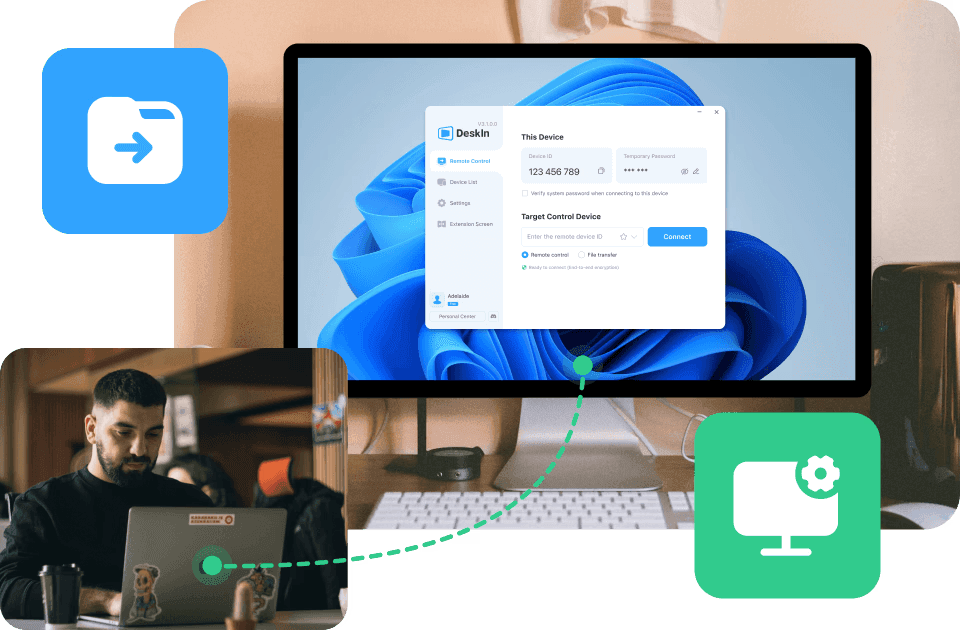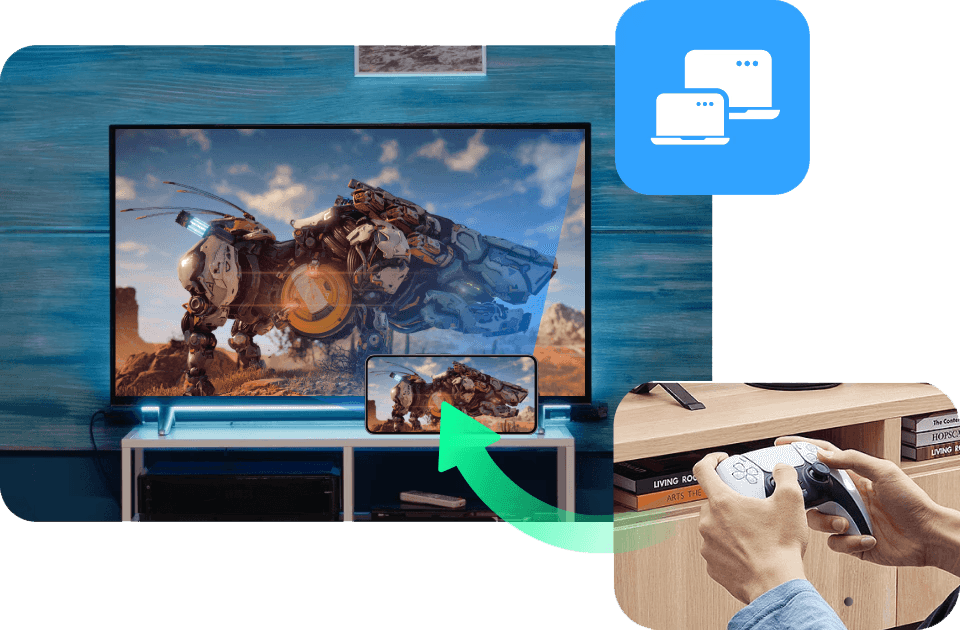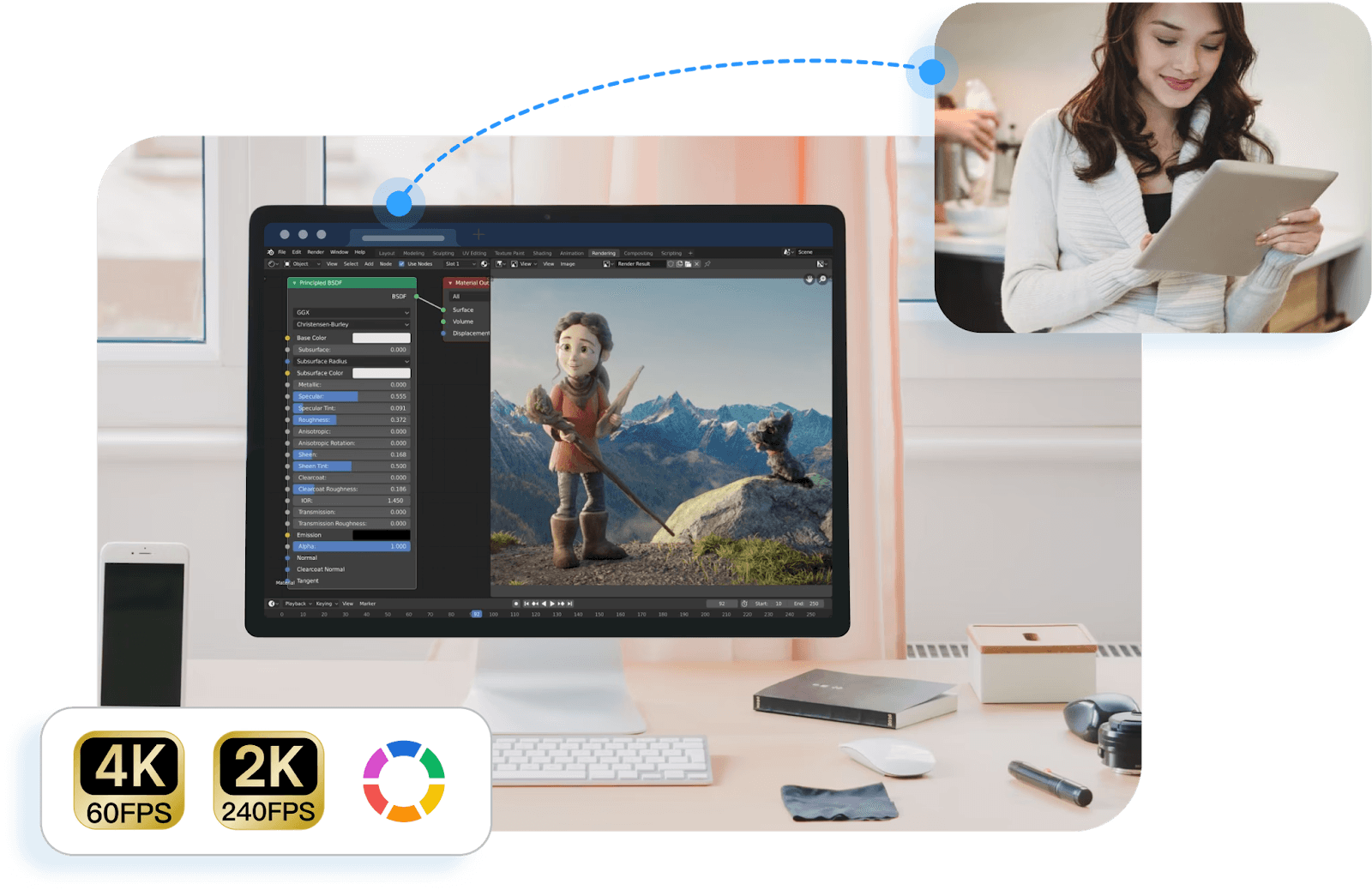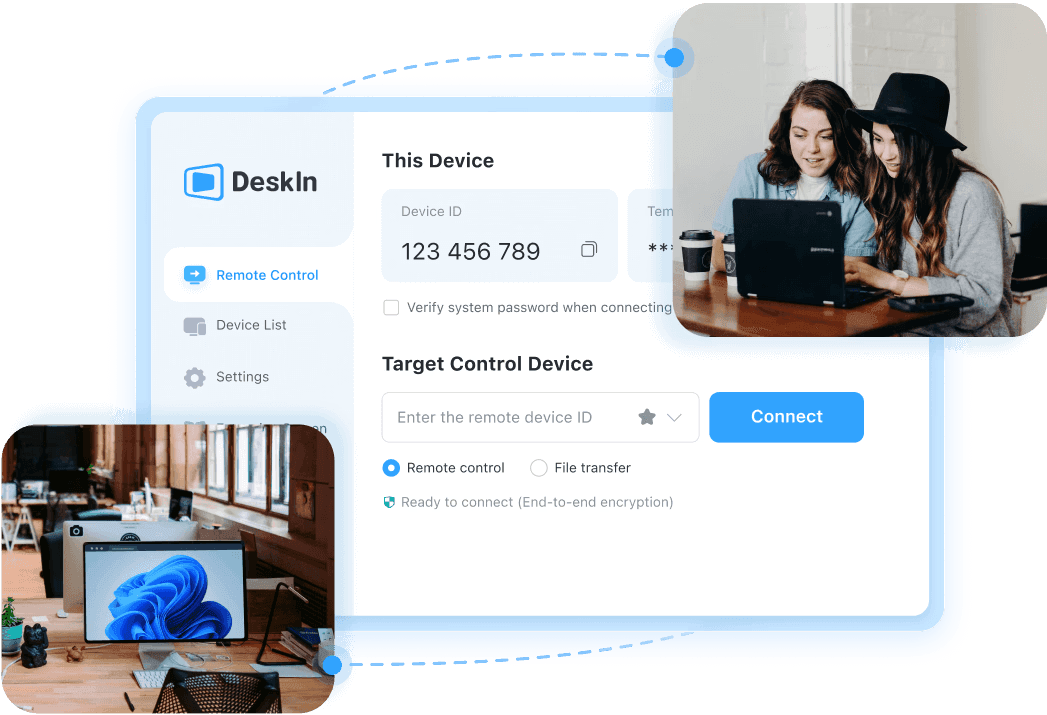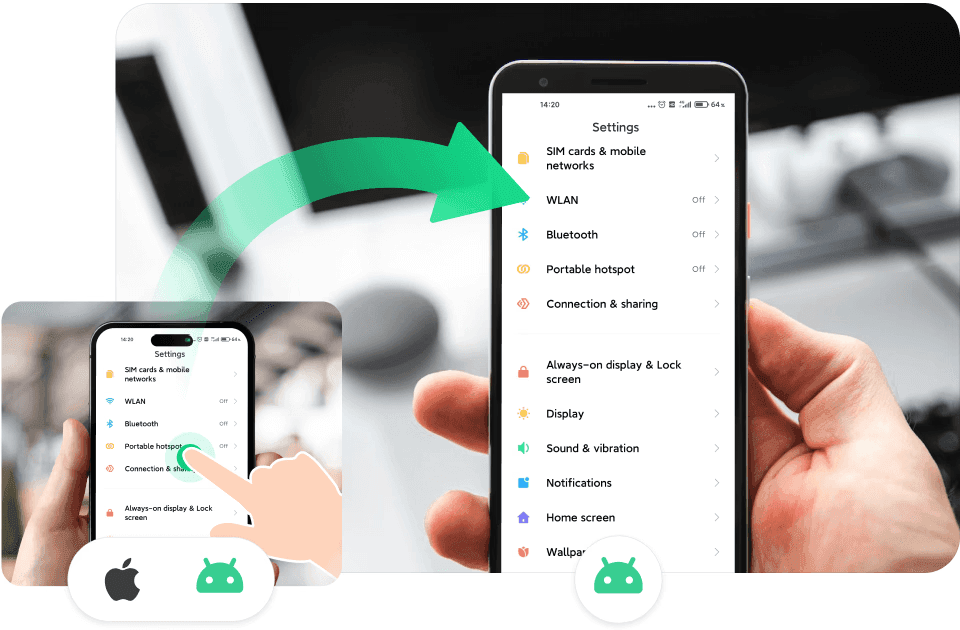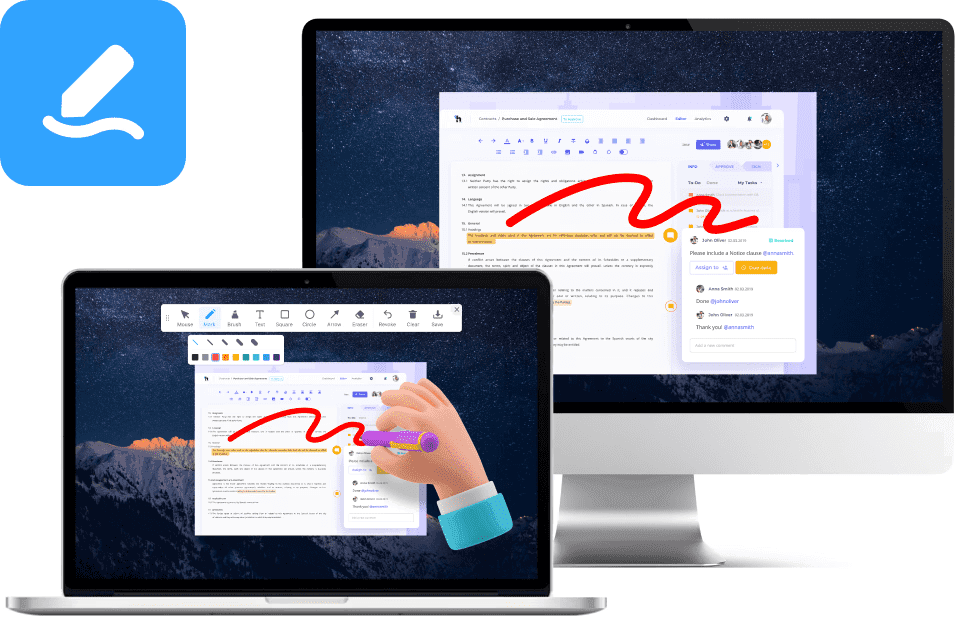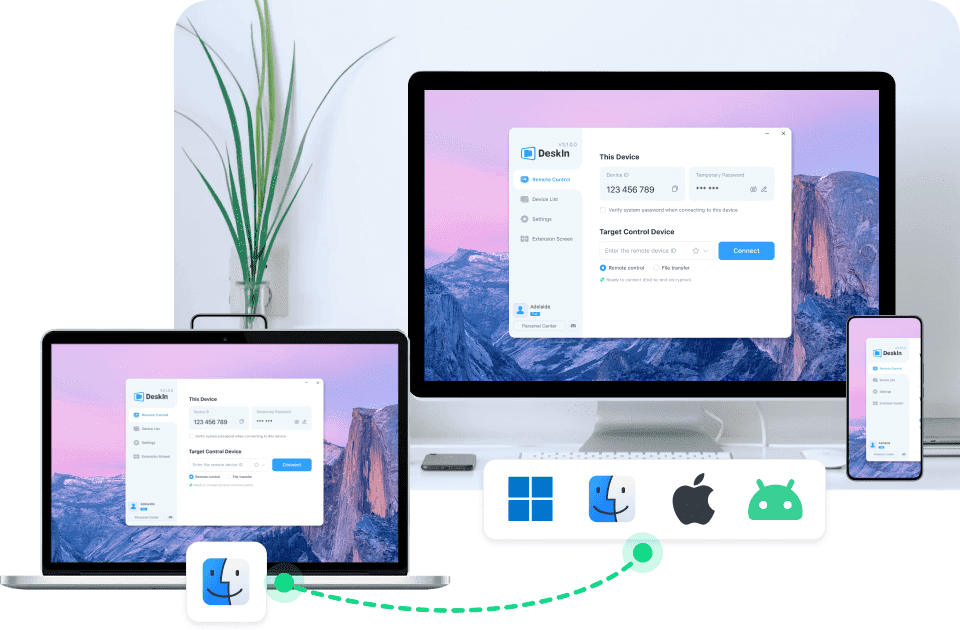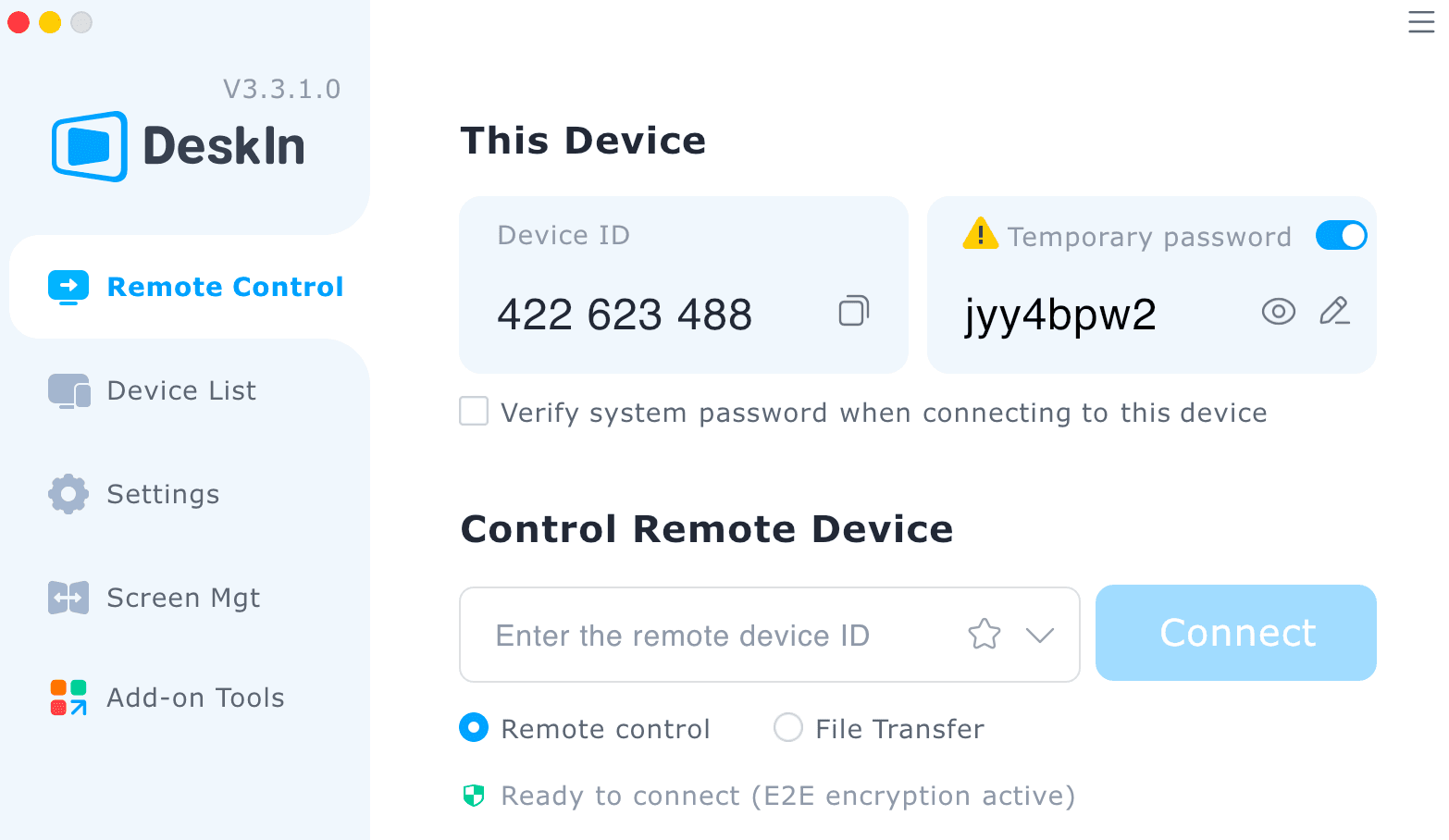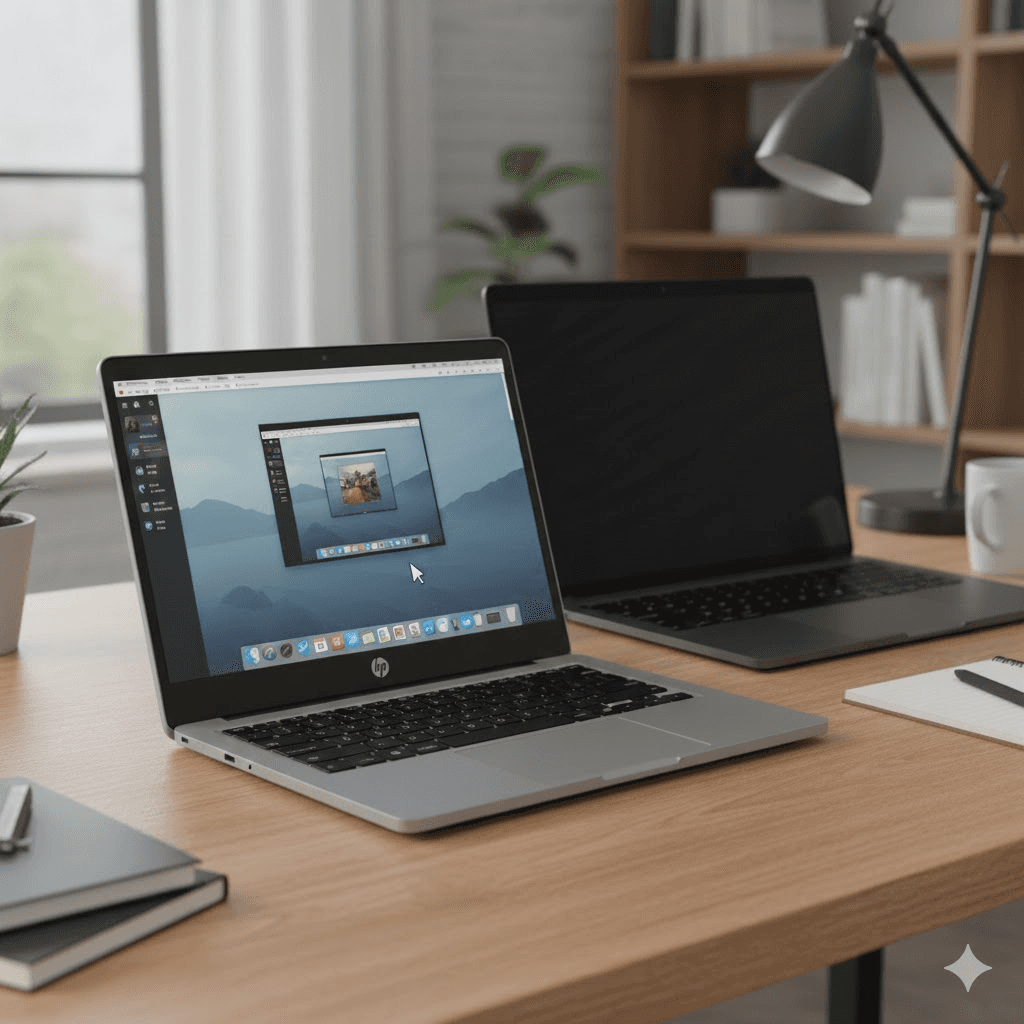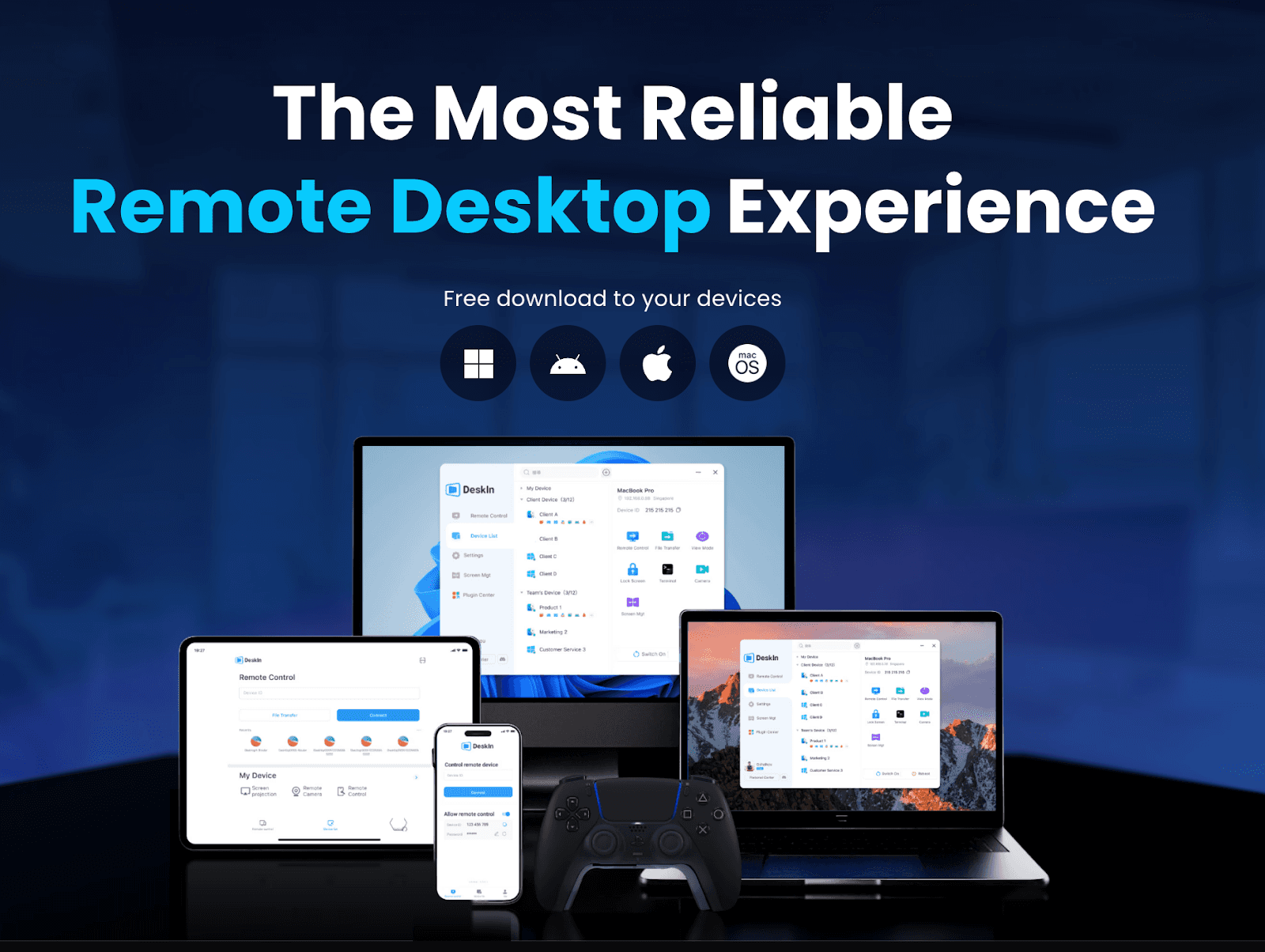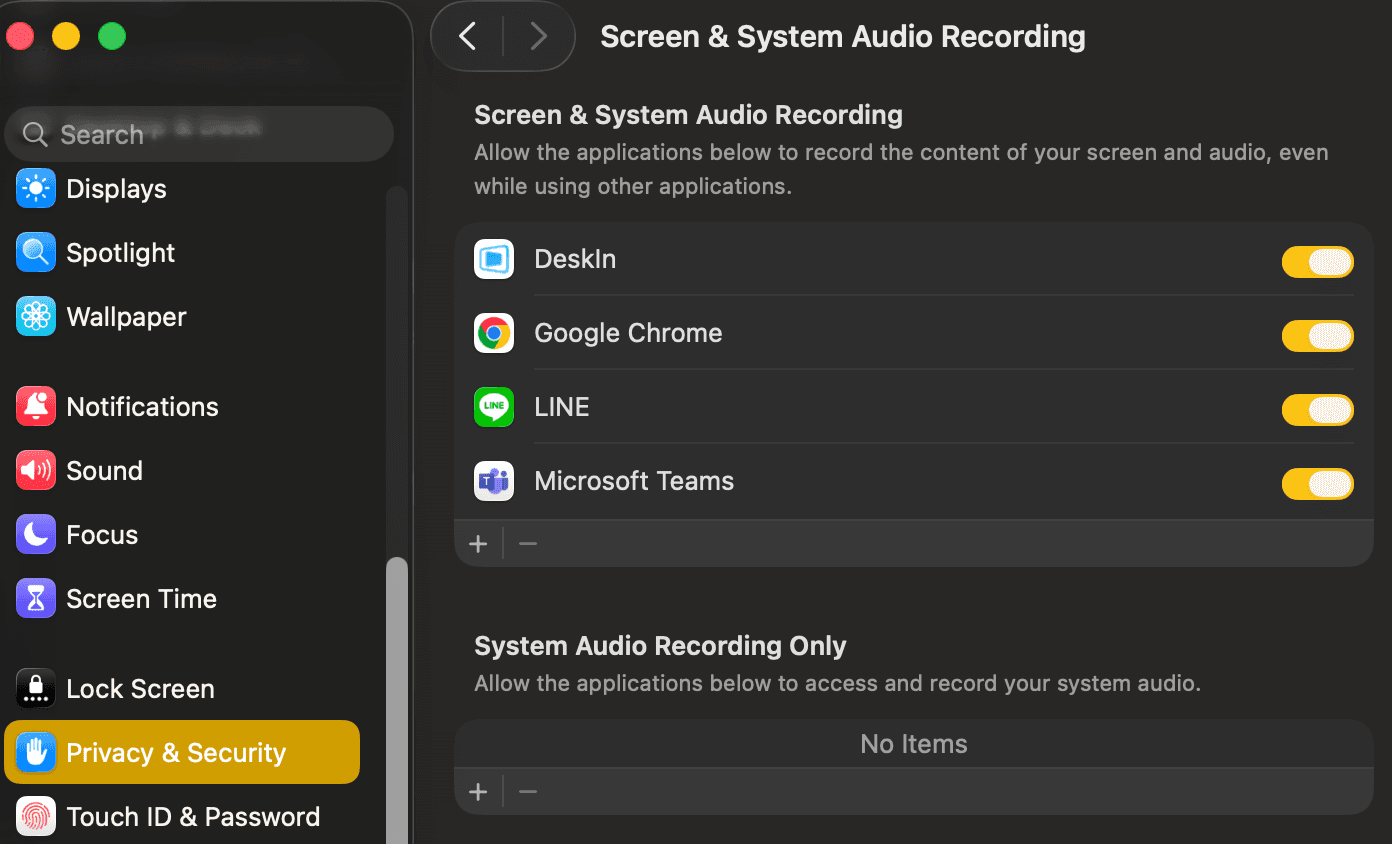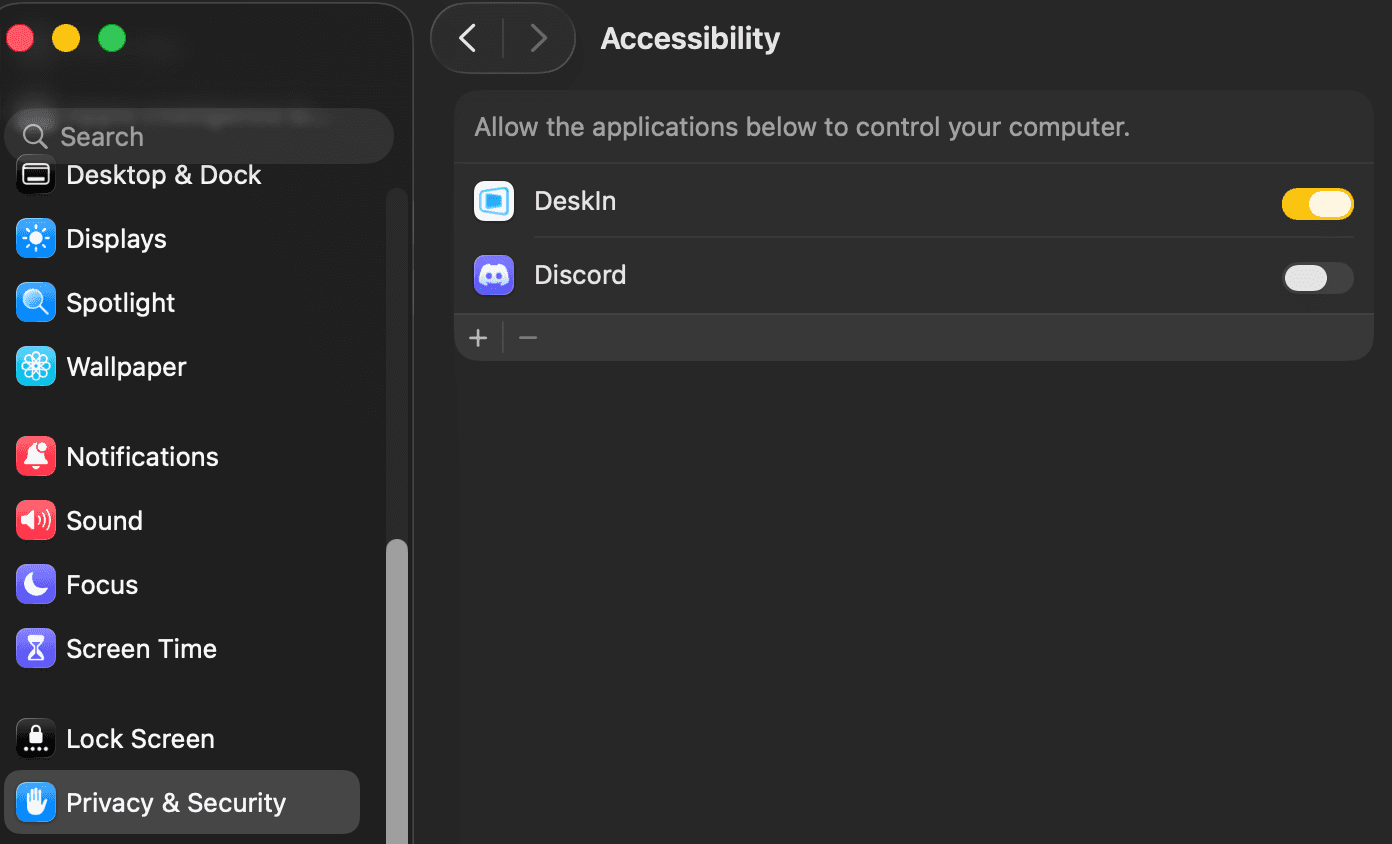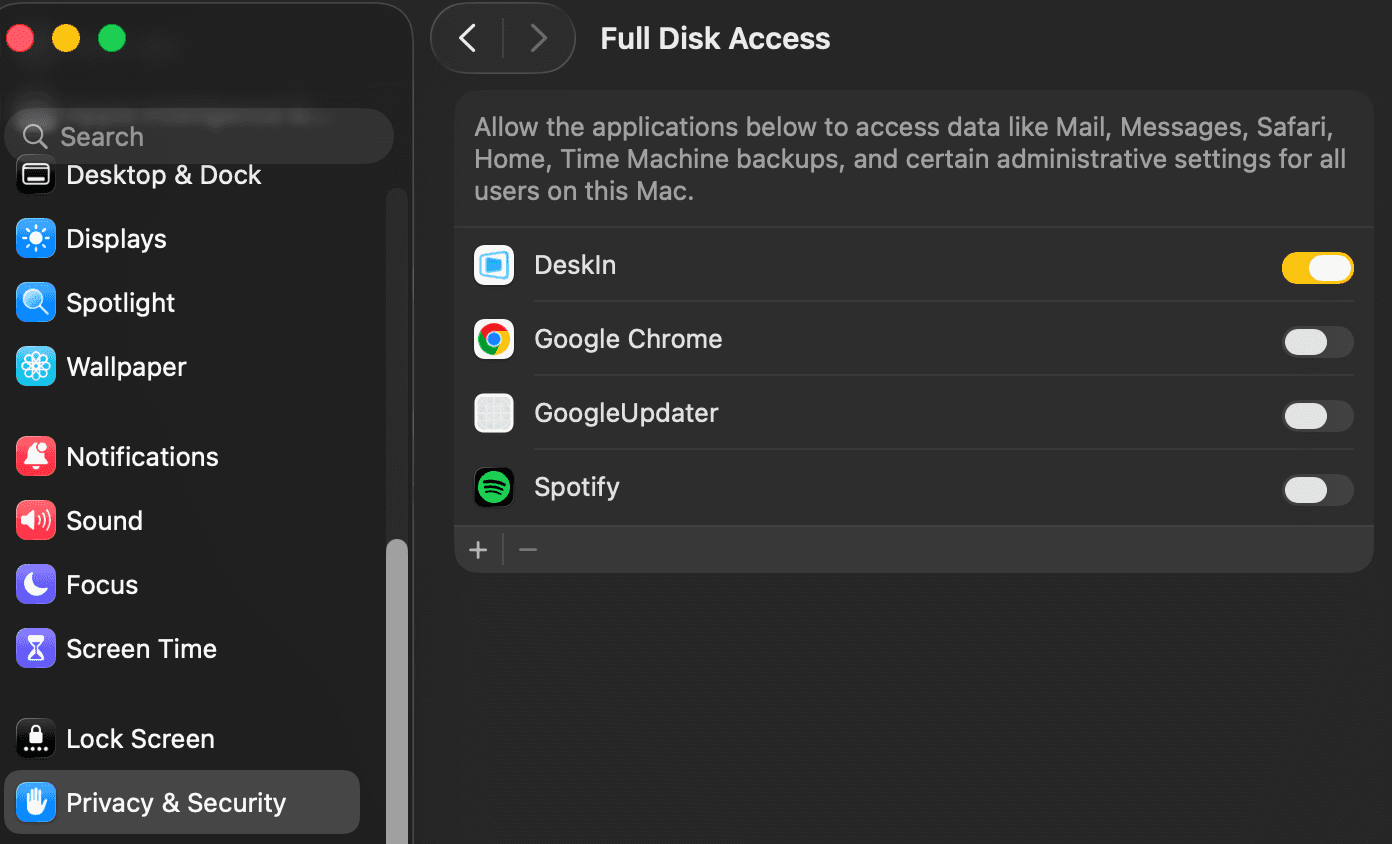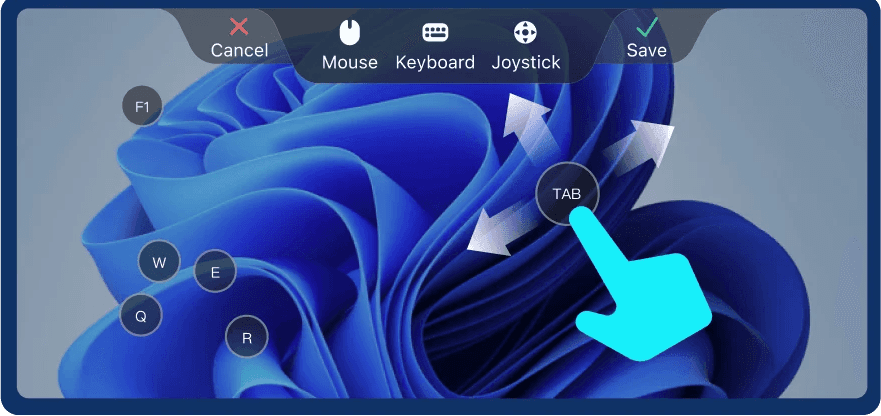因為工作關係,常常要用到遠端桌面軟體,因此花了一些時間測試 5 款免費遠端桌面軟體,包括 Teamviewer、DeskIn、Anydesk、Awesun 和 Parsec,這裡就分享實測下來幾款在遠端工作、遠端遊戲、遠端觀看影片上的表現,提供給在尋找好用的遠端軟體、或有遠端作業需求的人參考。作者大多數用手機遠端 PC,以及 MacBook 遠端 PC,所以下面的測試比較,都是這種使用環境為主。
免費遠端桌面軟體規格比較表

注: 這裡說的四大平台是 Windows、Mac、iOS 和 Android。
遠端工作:DeskIn優勝Awesun
這 5 款遠端桌面軟體,免費版只有 DeskIn 和 Awesun 可以商用,Teamviewer,Anydesk 和 Parsec 都必須升級付費版才可以,因此在遠端工作情境中,我主要比較 DeskIn 和 Awesun 這二個。
基本操作比較:DeskIn更加直覺順手
DeskIn 和 Awesun 電腦版的操作介面都比較簡潔,一些我會用到的功能都能很快找到,如:文字對話、快速切換雙螢幕畫面。但整體連缐速度和穩定性DeskIn會更高,Awesun相對卡頓感會更强。
操作上,Awesun 的滾輪滑動距離很短,不像 DeskIn 滑動很順,在瀏覽頁面和網頁時感受很明顯。

DeskIn桌面端
DeskIn 手機版可說是我用過最順手的一款,我非常喜歡它的觸控 + 滑鼠混合模式,可以隨時依不同需求快速切換,搭配一些手勢,瀏覽網頁,切換視窗都很方便:

畫面反應速度也極快,就算是用手機,也能很順暢的完成遠端工作。也提供一些不錯的功能,像是跟遠端設備發訊息、語音通話,內建可快速切換視窗的「任務視圖」,這個我覺得非常好用,手機也能很容易切換其他要用的視窗:

Awesun 手機版也有觸控 + 滑鼠混合,另外我還蠻喜歡一點是,功能選單只有單層設計,對手機很友善,可很快找到要使用的功能。但相較於 DeskIn,Awesun 提供的實用功能比較少,尤其是沒有任務視圖快捷鍵,切換視窗就變得困難很多。也沒有跟遠端裝置溝通的功能比如語音通話,必須用其他 App,對於遠端協作來説比較不方便。

檔案傳輸比較:DeskIn無速度、檔案大小限制
DeskIn 手機版的傳輸檔案功能是付費會員專屬,這點比較可惜,但電腦版免費用戶就能用。傳輸速度還蠻快的,可以拖拽傳檔,同個網路,透過 Wi-Fi 傳輸 5GB 檔案大約僅花 3 分多鐘。Awesun 電腦版、手機版都能免費使用傳輸檔案功能,不過有檔案大小限制,超過 1GB 的檔案就不行,所以使用上有侷限。

遠端輸入比較:DeskIn快捷按鍵超順手
打字部分,電腦版都差不多,所以就不比較,只分享手機遠端電腦的體驗。
DeskIn 和 Awesun 手機版鍵盤都大約只佔畫面一半,所以用手機遠端打字起來都還蠻舒服的。
DeskIn 有一個很大的優點,它可以把常用快捷鍵固定懸浮在鍵盤上方或是遠端畫面,像是複製貼上,打字時,我可以很容易複製想要的內容,然後貼在需要的位置,也可以自訂快捷按鍵:

Awesun 就不一樣,它是隱藏在快捷鍵選單裡面,當我選取要複製的內容,還要切換到快捷鍵選單,然後按複製,再切回鍵盤,貼上也一樣,操作相當麻煩
另外,按好快捷鍵後,返回鍵盤是按「默認」,不是「X」 ,但這取名很怪,剛開始我很長按錯,有時候真的會抓狂。
另外三款的操作介面,這邊也簡短分享一下:
Teamviewer:功能齊全但傳檔龜速,手機端操作不順手
連缐較慢:不知道是不是免費版原因,我用下來電腦版和手機版按連線之後都會慢半拍,特別是手機,一開始我還以為是沒點到,結果最後點太多下,顯示重複連線的錯誤。
功能齊全:電腦版功能蠻齊全的,該有的都有,還有提供「留下訊息功能」,遠端階段結束後,訊息會保留下來,如果是幫別人修電腦、傳檔案之類,就能用這功能留下要告訴對方的內容:

傳檔較慢:Teamviewer 電腦版和手機版都能使用傳輸檔案功能。不過,免費版傳檔速度有點驚訝的慢,5GB 竟然要花費 30 幾分鐘才完成。
行動端操作不順手:手機版的滑鼠功能不支援觸控和鼠標共用,需要進到選單切換,操作上不是很方便。複製和貼上的快捷鍵也沒有跟鍵盤整合,而是在另一個選單裡,打字時不太容易複製或貼上內容:

誤判商用:另一個有點煩人的點是,免費版每次用完都會提醒不能用於商業用途,而且是二台設備都會跳出,沒辦法永久關掉

Anydesk:傳檔高速,中文輸入異常
Anydesk電腦版無需安裝登入即可使用,比較方便,但軟體的界面比較古早。很不錯的是檔案傳輸速度非常快,跟 DeskIn 有得拼,但連缐畫面就沒有很順暢,清晰度也不是很夠,特別是滑動頁面,可以明顯感受到慢個 1~2 秒,即便我設定「最佳化反應時間」也一樣。
手機版的功能表隱藏在右側,往左滑才會叫出,我還蠻喜歡這設計,遠端桌面的畫面更不受干擾,但 iPhone 和 Android 遠端 PC 都有一些輸入問題:
iPhone 的中文輸入法支援性不太好,我的 PC 是第三方的輸入法,遠端時沒辦法正常打字,只會出現注音符號,PC 必須切換到 Windows 內建輸入法才能正常打字;
Android 雖然可以正常輸入,但沒辦法操作刪除動作,必須關掉然後重新打開鍵盤才可以。另外切換中文、英文鍵盤時,有時候手機的鍵盤也會突然消失。

Parsec:適合遊戲,基本無辦公功能
Parsec 是唯一一款不支援中文的遠端桌面軟體,不過設置還蠻簡單,安裝好並登入帳號,就能開始遠端連線。
電腦版幾乎沒有什麼功能,連傳輸檔案都不行,只能調整畫面和傳輸設定。手機版僅支援 Android,所以 iPhone 沒辦法用,不過也沒差,因為這款的手機版非常陽春,就只能操控跟打字,畫面還無法放大、不能輸入中文,很不好用:
Parsec 比較適合用在遊戲用途,工作或一般使用完全不推薦。

遠端遊戲情境比較
遊戲部分我測試「用 MacBook 遠端玩 PC 上的暗黑破壞神四」,來試試每一款的連線品質和延遲狀況。這也是我偶爾會用到的狀況,有時候帶 MacBook Pro 出門工作,休息時會想玩遊戲,而家裡的 PC 如果開著,就能用遠端軟體輕鬆實現。
Teamviewer
首先我測試 Teamviewer,雖然玩是沒問題,但明顯就是感覺到不順,有時候移動會慢半拍、甚至畫面頓了一下,玩起來體驗沒有那麼好,不太推薦。我也有測試過品質設定在「速度優先」,狀況一樣沒有改善。
DeskIn
再來是 DeskIn,就讓我相當滿意,畫面清晰度高,遊玩 30 分鐘都很順,另外可以看到即時的幀率和延遲度,很不錯。它還有提供 4K 60fps、144fps 的選項,對遊戲應該會更加分,不過僅付費版:

Anydesk
Anydesk 的畫質可說是 5 款當中最好,玩起來也順,但我有發現一個比較麻煩的問題,玩的過程中,我遠端電腦 CPU 佔用率飆升到 70%~80%,導致電腦風扇快速運轉,聲音很大,讓人有點擔心玩久電腦會不會出狀況,不是很放心:

Awesun
Awesun 唯獨切換遊戲場景會稍微頓一下(如:回城),其他都還蠻順的。但這款的 Mac 版好像穩定性有問題,我遠端過一次後,下次再次打開就會當掉,需要重灌軟體才會修復,也沒有聲音:

Parsec
Parsec 遠端遊戲果然很不錯,玩暗黑四順暢度一流,而且有提供頻寬設定,可以根據當前狀況,調整使用的頻寬,進而讓畫面變得更順、延遲度更低。也可以創建房間進行多人遊戲,如果你只有遠端遊戲的需求,可以盲選這款。

遠端觀看影片比較
用手機遠端連回電腦看影片,可以很快速的測出每一款遠端軟體的延遲表現。
我測試多部影片,從 YouTube、Netflix、到電腦裡的影片都有,播放都很順暢的有三款:Teamviewer、DeskIn 以及 Parsec,不過 Teamviewer 和 Parsec 有一些問題。
Teamviewer 雖然速度很順暢,但遠端後聲音很小,就算我把手機聲音調到最大也一樣,而且沒辦法設定靜音,意味著如果電腦有聲音正在播放,那手機就會發出聲音。
Parsec 的速度和聲音品質都相當不錯,但因為手機版沒辦法縮放畫面,因此只能全螢幕播放。
DeskIn 就沒有以上這些問題,各方面都讓人滿意。
至於 Anydesk,畫面是很順,不過目前手機版的傳輸音效是壞的,iOS 和 Android 都是,我有確認過功能開啟,手機也調到最大聲且關閉靜音,還是沒有聲音。
Awesun 就蠻差的,聲音會斷斷續續,而且無法跟畫面同步,由此可見連線品質不是很好。
如何選擇遠端桌面軟體
在選擇遠端桌面軟體時,「功能」和「連線品質」可說是最重要,功能一定要能滿足你的使用需求,像是能不能傳輸檔案、跟遠端設備通訊、鍵盤打字順不順手。不同的軟體也會有一些不同的附加功能提高軟體可用性,像DeskIn就可以進行螢幕擴充和語音通話。
另外連線品質如果延遲太高,會大幅影響你的遠端操作效率,所以一定要延遲低的遠端軟體。
還有支援多平台,最好 iOS、Android、Windows、PC 都有,這樣未來無論換什麼平台,都能繼續進行遠端作業。
總結
我原本以為最有名的 Teamviewer,使用體驗上應該會最好,沒想到測試之後發現還蠻多缺點的,由此可見,真的要用過才知道哪一款最適合自己。
整體表現最讓我滿意的是 DeskIn,如果你正在找遠端桌面軟體,很推薦試試這款。
因為工作關係,常常要用到遠端桌面軟體,因此花了一些時間測試 5 款免費遠端桌面軟體,包括 Teamviewer、DeskIn、Anydesk、Awesun 和 Parsec,這裡就分享實測下來幾款在遠端工作、遠端遊戲、遠端觀看影片上的表現,提供給在尋找好用的遠端軟體、或有遠端作業需求的人參考。作者大多數用手機遠端 PC,以及 MacBook 遠端 PC,所以下面的測試比較,都是這種使用環境為主。
免費遠端桌面軟體規格比較表

注: 這裡說的四大平台是 Windows、Mac、iOS 和 Android。
遠端工作:DeskIn優勝Awesun
這 5 款遠端桌面軟體,免費版只有 DeskIn 和 Awesun 可以商用,Teamviewer,Anydesk 和 Parsec 都必須升級付費版才可以,因此在遠端工作情境中,我主要比較 DeskIn 和 Awesun 這二個。
基本操作比較:DeskIn更加直覺順手
DeskIn 和 Awesun 電腦版的操作介面都比較簡潔,一些我會用到的功能都能很快找到,如:文字對話、快速切換雙螢幕畫面。但整體連缐速度和穩定性DeskIn會更高,Awesun相對卡頓感會更强。
操作上,Awesun 的滾輪滑動距離很短,不像 DeskIn 滑動很順,在瀏覽頁面和網頁時感受很明顯。

DeskIn桌面端
DeskIn 手機版可說是我用過最順手的一款,我非常喜歡它的觸控 + 滑鼠混合模式,可以隨時依不同需求快速切換,搭配一些手勢,瀏覽網頁,切換視窗都很方便:

畫面反應速度也極快,就算是用手機,也能很順暢的完成遠端工作。也提供一些不錯的功能,像是跟遠端設備發訊息、語音通話,內建可快速切換視窗的「任務視圖」,這個我覺得非常好用,手機也能很容易切換其他要用的視窗:

Awesun 手機版也有觸控 + 滑鼠混合,另外我還蠻喜歡一點是,功能選單只有單層設計,對手機很友善,可很快找到要使用的功能。但相較於 DeskIn,Awesun 提供的實用功能比較少,尤其是沒有任務視圖快捷鍵,切換視窗就變得困難很多。也沒有跟遠端裝置溝通的功能比如語音通話,必須用其他 App,對於遠端協作來説比較不方便。

檔案傳輸比較:DeskIn無速度、檔案大小限制
DeskIn 手機版的傳輸檔案功能是付費會員專屬,這點比較可惜,但電腦版免費用戶就能用。傳輸速度還蠻快的,可以拖拽傳檔,同個網路,透過 Wi-Fi 傳輸 5GB 檔案大約僅花 3 分多鐘。Awesun 電腦版、手機版都能免費使用傳輸檔案功能,不過有檔案大小限制,超過 1GB 的檔案就不行,所以使用上有侷限。

遠端輸入比較:DeskIn快捷按鍵超順手
打字部分,電腦版都差不多,所以就不比較,只分享手機遠端電腦的體驗。
DeskIn 和 Awesun 手機版鍵盤都大約只佔畫面一半,所以用手機遠端打字起來都還蠻舒服的。
DeskIn 有一個很大的優點,它可以把常用快捷鍵固定懸浮在鍵盤上方或是遠端畫面,像是複製貼上,打字時,我可以很容易複製想要的內容,然後貼在需要的位置,也可以自訂快捷按鍵:

Awesun 就不一樣,它是隱藏在快捷鍵選單裡面,當我選取要複製的內容,還要切換到快捷鍵選單,然後按複製,再切回鍵盤,貼上也一樣,操作相當麻煩
另外,按好快捷鍵後,返回鍵盤是按「默認」,不是「X」 ,但這取名很怪,剛開始我很長按錯,有時候真的會抓狂。
另外三款的操作介面,這邊也簡短分享一下:
Teamviewer:功能齊全但傳檔龜速,手機端操作不順手
連缐較慢:不知道是不是免費版原因,我用下來電腦版和手機版按連線之後都會慢半拍,特別是手機,一開始我還以為是沒點到,結果最後點太多下,顯示重複連線的錯誤。
功能齊全:電腦版功能蠻齊全的,該有的都有,還有提供「留下訊息功能」,遠端階段結束後,訊息會保留下來,如果是幫別人修電腦、傳檔案之類,就能用這功能留下要告訴對方的內容:

傳檔較慢:Teamviewer 電腦版和手機版都能使用傳輸檔案功能。不過,免費版傳檔速度有點驚訝的慢,5GB 竟然要花費 30 幾分鐘才完成。
行動端操作不順手:手機版的滑鼠功能不支援觸控和鼠標共用,需要進到選單切換,操作上不是很方便。複製和貼上的快捷鍵也沒有跟鍵盤整合,而是在另一個選單裡,打字時不太容易複製或貼上內容:

誤判商用:另一個有點煩人的點是,免費版每次用完都會提醒不能用於商業用途,而且是二台設備都會跳出,沒辦法永久關掉

Anydesk:傳檔高速,中文輸入異常
Anydesk電腦版無需安裝登入即可使用,比較方便,但軟體的界面比較古早。很不錯的是檔案傳輸速度非常快,跟 DeskIn 有得拼,但連缐畫面就沒有很順暢,清晰度也不是很夠,特別是滑動頁面,可以明顯感受到慢個 1~2 秒,即便我設定「最佳化反應時間」也一樣。
手機版的功能表隱藏在右側,往左滑才會叫出,我還蠻喜歡這設計,遠端桌面的畫面更不受干擾,但 iPhone 和 Android 遠端 PC 都有一些輸入問題:
iPhone 的中文輸入法支援性不太好,我的 PC 是第三方的輸入法,遠端時沒辦法正常打字,只會出現注音符號,PC 必須切換到 Windows 內建輸入法才能正常打字;
Android 雖然可以正常輸入,但沒辦法操作刪除動作,必須關掉然後重新打開鍵盤才可以。另外切換中文、英文鍵盤時,有時候手機的鍵盤也會突然消失。

Parsec:適合遊戲,基本無辦公功能
Parsec 是唯一一款不支援中文的遠端桌面軟體,不過設置還蠻簡單,安裝好並登入帳號,就能開始遠端連線。
電腦版幾乎沒有什麼功能,連傳輸檔案都不行,只能調整畫面和傳輸設定。手機版僅支援 Android,所以 iPhone 沒辦法用,不過也沒差,因為這款的手機版非常陽春,就只能操控跟打字,畫面還無法放大、不能輸入中文,很不好用:
Parsec 比較適合用在遊戲用途,工作或一般使用完全不推薦。

遠端遊戲情境比較
遊戲部分我測試「用 MacBook 遠端玩 PC 上的暗黑破壞神四」,來試試每一款的連線品質和延遲狀況。這也是我偶爾會用到的狀況,有時候帶 MacBook Pro 出門工作,休息時會想玩遊戲,而家裡的 PC 如果開著,就能用遠端軟體輕鬆實現。
Teamviewer
首先我測試 Teamviewer,雖然玩是沒問題,但明顯就是感覺到不順,有時候移動會慢半拍、甚至畫面頓了一下,玩起來體驗沒有那麼好,不太推薦。我也有測試過品質設定在「速度優先」,狀況一樣沒有改善。
DeskIn
再來是 DeskIn,就讓我相當滿意,畫面清晰度高,遊玩 30 分鐘都很順,另外可以看到即時的幀率和延遲度,很不錯。它還有提供 4K 60fps、144fps 的選項,對遊戲應該會更加分,不過僅付費版:

Anydesk
Anydesk 的畫質可說是 5 款當中最好,玩起來也順,但我有發現一個比較麻煩的問題,玩的過程中,我遠端電腦 CPU 佔用率飆升到 70%~80%,導致電腦風扇快速運轉,聲音很大,讓人有點擔心玩久電腦會不會出狀況,不是很放心:

Awesun
Awesun 唯獨切換遊戲場景會稍微頓一下(如:回城),其他都還蠻順的。但這款的 Mac 版好像穩定性有問題,我遠端過一次後,下次再次打開就會當掉,需要重灌軟體才會修復,也沒有聲音:

Parsec
Parsec 遠端遊戲果然很不錯,玩暗黑四順暢度一流,而且有提供頻寬設定,可以根據當前狀況,調整使用的頻寬,進而讓畫面變得更順、延遲度更低。也可以創建房間進行多人遊戲,如果你只有遠端遊戲的需求,可以盲選這款。

遠端觀看影片比較
用手機遠端連回電腦看影片,可以很快速的測出每一款遠端軟體的延遲表現。
我測試多部影片,從 YouTube、Netflix、到電腦裡的影片都有,播放都很順暢的有三款:Teamviewer、DeskIn 以及 Parsec,不過 Teamviewer 和 Parsec 有一些問題。
Teamviewer 雖然速度很順暢,但遠端後聲音很小,就算我把手機聲音調到最大也一樣,而且沒辦法設定靜音,意味著如果電腦有聲音正在播放,那手機就會發出聲音。
Parsec 的速度和聲音品質都相當不錯,但因為手機版沒辦法縮放畫面,因此只能全螢幕播放。
DeskIn 就沒有以上這些問題,各方面都讓人滿意。
至於 Anydesk,畫面是很順,不過目前手機版的傳輸音效是壞的,iOS 和 Android 都是,我有確認過功能開啟,手機也調到最大聲且關閉靜音,還是沒有聲音。
Awesun 就蠻差的,聲音會斷斷續續,而且無法跟畫面同步,由此可見連線品質不是很好。
如何選擇遠端桌面軟體
在選擇遠端桌面軟體時,「功能」和「連線品質」可說是最重要,功能一定要能滿足你的使用需求,像是能不能傳輸檔案、跟遠端設備通訊、鍵盤打字順不順手。不同的軟體也會有一些不同的附加功能提高軟體可用性,像DeskIn就可以進行螢幕擴充和語音通話。
另外連線品質如果延遲太高,會大幅影響你的遠端操作效率,所以一定要延遲低的遠端軟體。
還有支援多平台,最好 iOS、Android、Windows、PC 都有,這樣未來無論換什麼平台,都能繼續進行遠端作業。
總結
我原本以為最有名的 Teamviewer,使用體驗上應該會最好,沒想到測試之後發現還蠻多缺點的,由此可見,真的要用過才知道哪一款最適合自己。
整體表現最讓我滿意的是 DeskIn,如果你正在找遠端桌面軟體,很推薦試試這款。

Play x Work
All at Once
DeskIn Remote Game
only $14.32 USD 🎉 Limited on July 16-31
Add promo code: deskinsummer1





